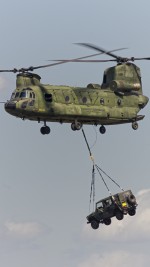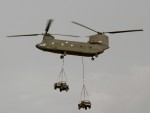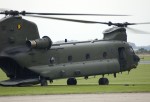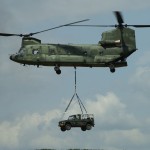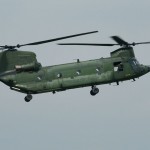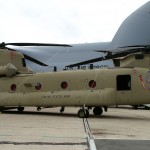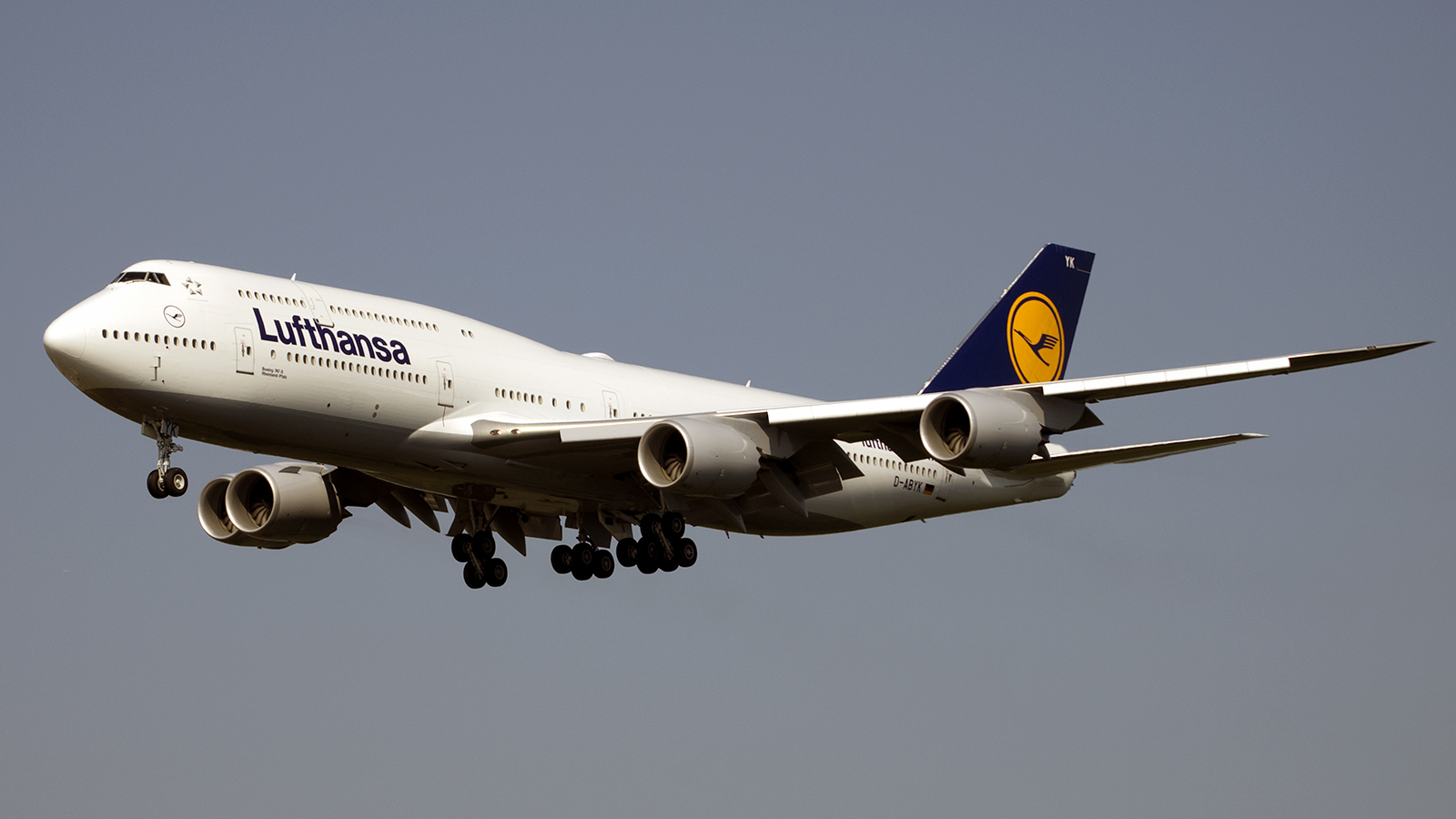
The Boeing CH-47 Chinook is an American twin-engine, tandem rotor heavy-lift helicopter. Its primary mission is to move troops, artillery, ammunition, fuel, water, barrier materials, supplies and equipment on the battlefield. Its secondary missions include medical evacuation, disaster relief, search and rescue, aircraft recovery, fire fighting, parachute drops, heavy construction and civil development.
Developing nation: USA.
Manufacturer/designer: Boeing.
Production line: Boeing facility in Ridley Park, Pennsylvania.
Type aircraft: heavy-lift transport.
First flight: 21 September 1961.
Produced: 1961 – present.
Built: 1,200+.
Chinook helicopters were introduced in 1962 as the CH-47 Chinook, and models A, B and C were deployed in Vietnam. As the product of a modernization program, which included refurbishing existing CH-47s, the first CH-47Ds were delivered in 1982 and were produced until 1994. A central element in the Gulf War, they continue to be the standard for the U.S. Army in the global campaign against terrorism.
CH-47s also have performed humanitarian support, disaster relief, rescue, fire-fighting and nation-building missions on six continents in all climates and conditions. With a crew of three, the CH-47s can transport 44 seated troops or 24 casualty litters. The aircraft can carry palletized cargo internally, including the U.S. Army HMMWV, or sling-loaded external cargo, utilizing its triple cargo hooks for stability.
Boeing is developing new composite rotor blades for the CH-47 Chinook helicopter that will increase lift capacity by 907kg. The new rotors will be available from 2014, and can be retrofitted to previous examples of the Chinook.
Variants
HC-1B – The pre-1962 designation for Model 114 development aircraft that would be re-designated CH-47 Chinook.
CH-47A – The all-weather, medium-lift CH-47A Chinook. A total of 349 were built.
ACH-47A – Four CH-47A helicopters were converted to gunships by Boeing Vertol in late 1965.
CH-47B – The CH-47B was an interim solution while Boeing worked on a more substantially improved CH-47C. 108 built.
CH-47C – The CH-47C featured more powerful engines and transmissions. Three versions of the “C model” were built.
CH-47D – The CH-47D model was originally powered by two T55-L-712 engines, but most are now fitted with the T55-GA-714A.
MH-47D – The MH-47D variant was developed for special forces operations and has in-flight refueling capability, a fast-rope rappelling system and other upgrades.
EH-47D – The current model used by US Army Special Operations is the MH-47E. Beginning with the E model prototype manufactured in 1991, there were a total of 26 Special Operations Aircraft produced.
CH-47F – The CH-47F was designed to extend the service life of the Chinook class beyond 2030. Among its upgrades are new 4,868 shaft horsepower Honeywell engines, improved avionics, and an upgraded airframe with larger single-piece sections to reduce part count and need for fasteners. The new milled construction will reduce vibrations, eliminate points of joint flexing, and reduce the need for inspections and repairs, and reduce maintenance costs. It is also expected to increase service life. The CH-47F can fly at speeds of over 282 km/h (175 mph) with a payload of more than 9,530 kg (21,000 lb). The improved avionics include a Rockwell Collins Common Avionics Architecture System (CAAS) cockpit, and BAE Systems’ Digital Advanced Flight Control System (DAFCS).In February 2007, the Netherlands were the first international customer to order the F model; six helicopters were ordered to expand their current fleet to 17. The Netherlands also plans to upgrade its current 11 CH-47Ds to the CH-47F configuration.
MH-47G – The MH-47G Special Operations Aviation (SOA) version is currently being delivered to the US Army. The MH47G’s fully integrated digital Common Avionics Architecture System (CAAS) permits global communications and navigation. CAAS is among the most advanced U.S. Army helicopter systems, soon to be installed in the U.S. Army Special Operations Command’s MH60. CAAS includes integrated forwardlooking infrared (FLIR) and multimode radar for napoftheearth and lowlevel flight operations in conditions of extremely poor visibility and adverse weather. Today’s MH47Gs contain a fully integrated digital cockpit management system, longrange fuel tanks and advanced cargohandling capabilities that complement the aircraft’s mission performance and handling characteristics. In February 2007, the first MH47G aircraft were deployed in Afghanistan.
Military Operators
Australia
Canada
Egypt
Greece
Iran
Italy
Japan
Libya
Morocco
Netherlands
Republic of China (Taiwan)
Saudi Arabia
Singapore
South Korea
Spain
Thailand
Turkey
United Kingdom
United Arab Emirates
United States
General characteristics CH-47D
- Crew: 3 (pilot, copilot, flight engineer/loadmaster)
- Capacity:
- 33–55 troops or
- 24 litters and 3 attendants or
- 12,700 kg (28,000 lb) cargo
- Length: 30.1 m (98 ft 10 in)
- Rotor diameter: 18.3 m (60 ft 0 in)
- Height: 5.7 m (18 ft 11 in)
- Disc area: 260 m2 (5,600 ft2 or 2,800 ft2 per rotor disc)
- Empty weight: 10,185 kg (23,400 lb)
- Loaded weight: 12,100 kg (26,680 lb)
- Max. takeoff weight: 22,680 kg (50,000 lb)
- Powerplant: 2 × Lycoming T55-GA-712 turboshaft, 3,750 hp (2,796 kW) each
Performance
- Maximum speed: 315 km/h (170 knots, 196 mph)
- Cruise speed: 220 km/h (130 kt, 137 mph)
- Range: 741 km (400 nmi, 450 mi)
- Ferry range: 2,252 km (1,216 nmi, 1,400 mi)
- Service ceiling: 5,640 m (18,500 ft)
- Rate of climb: 10.1 m/s (1,522 ft/min)
- Disc loading: 47 kg/m2 (9.5 lb/ft2)
- Power/mass: 460 W/kg (0.28 hp/lb)
Armament
- up to 3 pintle mounted medium machine guns (1 on loading ramp and 2 at shoulder windows), generally 7.62 mm (0.308 in) M240/FN MAG machine guns
Avionics
- Rockwell CAAS (MH-47G/CH-47F)
All pictures courtesy of Zijde Aviation Photo and Publishing, Rob Vogelaar.









